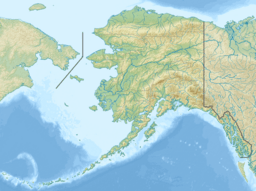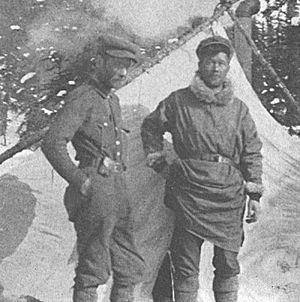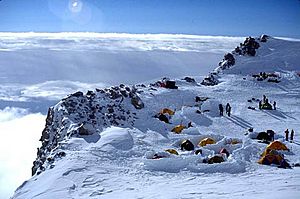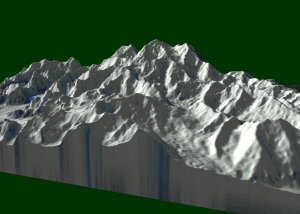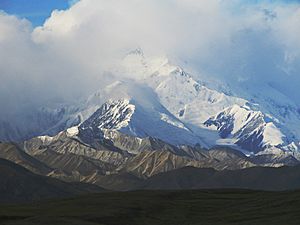Denali facts for kids
Quick facts for kids Denali |
|
|---|---|
| Mount McKinley | |
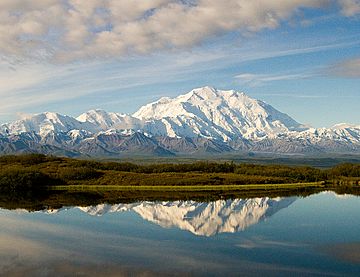
From the north, with Wonder Lake in the foreground
|
|
| Highest point | |
| Elevation | 20,310 ft (6,190 m) top of snow NAVD88 |
| Prominence | 20,156 ft (6,144 m) |
| Isolation | 4,621.1 mi (7,436.9 km) |
| Parent peak | Aconcagua |
| Listing |
|
| Geography | |
| Location | Denali National Park and Preserve, Alaska, US |
| Parent range | Alaska Range |
| Topo map | USGS Mt. McKinley A-3 |
| Climbing | |
| First ascent | June 7, 1913 by
|
| Easiest route | West Buttress Route (glacier/snow climb) |
Denali (/dəˈnɑːli/), also known as Mount McKinley, is the tallest mountain peak in North America. Its top reaches 20,310 feet (6,190 m) above sea level. It is also considered the tallest mountain in the world from its base to its peak on land, rising about 18,000 ft (5,500 m).
Denali is special because of its great height compared to the land around it. This is called topographic prominence. It has a prominence of 20,156 feet (6,144 m). It is also very far from other tall mountains, which is called topographic isolation. Denali's isolation is 4,621.1 miles (7,436.9 km). These features make Denali the third most prominent and third-most isolated peak on Earth, after Mount Everest and Aconcagua.
The mountain is located in the Alaska Range in the state of Alaska, United States. It is the main feature of Denali National Park and Preserve.
The native Koyukon people have called the mountain "Denali" for hundreds of years. This name means "the high one" or "the tall one." In 1896, a gold miner named it "Mount McKinley" to support William McKinley, who later became president. This name was officially used by the federal government of the United States from 1917 until 2015.
In August 2015, the United States Department of the Interior officially changed the mountain's federal name back to Denali. This happened 40 years after Alaska had already officially named it Denali. However, in January 2025, the Department of the Interior changed the official federal name back to Mount McKinley.
The first recorded attempt to climb Denali was in 1903 by James Wickersham, but it was not successful. In 1906, Frederick Cook claimed to have reached the top first, but this claim was later found to be false. The first confirmed climb to Denali's summit happened on June 7, 1913. The climbers were Hudson Stuck, Harry Karstens, Walter Harper, and Robert Tatum. In 1951, Bradford Washburn found the West Buttress route, which is now the safest and most popular way to climb the mountain.
On September 2, 2015, the U.S. Geological Survey measured the mountain's height as 20,310 feet (6,190 m). This was 10 feet lower than the 20,320 feet (6,194 m) measured in 1952.
Contents
Mountain Features
Denali is made mostly of a type of rock called granitic pluton, which is a pink rock called quartz monzonite. This rock was pushed up by strong forces in the Earth's crust. These forces happen when the Pacific Plate slides under the North American Plate. At the same time, the softer rock above Denali was worn away by erosion. The same forces that lifted Denali also cause many deep earthquakes in Alaska.
How Denali Got So Tall
Denali's great height is linked to the Denali Fault, a large crack in the Earth's crust. This fault moves sideways, and where it bends, it creates a "space problem." As the fault moves, it pushes the land upwards, making the mountain taller. The longer the land stays in this bent area, the higher it gets.
Mountain Height and Size
Denali's summit is 20,310 feet (6,190 m) above sea level. This makes it the highest peak in North America. It is also the northernmost mountain in the world that is over 19,685 feet (6,000 m) tall.
When measured from its base to its peak, Denali is one of the largest mountains on land. It rises from a flat area that is between 1,000 to 3,000 ft (300 to 910 m) high. This means its base-to-peak height is about 17,000 to 19,000 ft (5,000 to 6,000 m). For comparison, Mount Everest starts from a much higher base on the Tibetan Plateau. Everest's base is between 13,800 ft (4,200 m) and 17,100 ft (5,200 m). This means Everest's base-to-peak height is less than Denali's, ranging from 12,000 to 15,300 ft (3,700 to 4,700 m).
Parts of the Mountain
Denali has two main summits. The South Summit is the highest one. The North Summit is 19,470 ft (5,934 m) tall. The North Summit is not climbed as often as the South Summit.
Five large glaciers flow down from the mountain's sides:
- The Peters Glacier is on the northwest side.
- The Muldrow Glacier is on the northeast side.
- The Traleika Glacier is just east of the Muldrow.
- The Ruth Glacier is to the southeast.
- The Kahiltna Glacier is on the southwest side. It is the longest glacier in the Alaska Range, stretching 44 mi (71 km).
Naming the Mountain
The Koyukon Athabaskans have called the mountain "Denali" for centuries. This name comes from a Koyukon word meaning 'high' or 'tall'. When Russia owned Alaska, the mountain was called Bolshaya Gora, which means "Big Mountain" in Russian.
In 1896, a gold prospector named it "McKinley" to support William McKinley, who was running for president. The United States officially recognized the name Mount McKinley in 1917. In 1965, President Lyndon B. Johnson named the mountain's north and south peaks the "Churchill Peaks" after British leader Winston Churchill. Alaska officially changed the mountain's state name to "Denali" in 1975.
On August 28, 2015, the Obama administration changed the mountain's official federal name to Denali. This brought the federal name in line with Alaska's name. Secretary of the Interior Sally Jewell said this change was "a long time coming."
However, in December 2024, President-elect Donald Trump said he planned to change the name back to Mount McKinley. On January 20, 2025, shortly after his second inauguration, Trump signed an order to change the name back to Mount McKinley within 30 days. On January 23, 2025, the Department of the Interior officially changed the mountain's federal name back to Mount McKinley. This change does not affect the name of Denali National Park.
Hudson Stuck, who led the first confirmed team to reach the summit, preferred the name Denali. Businesses in Alaska are much more likely to be named after Denali than McKinley.
Many different Alaskan native languages have names for Denali. These names usually mean "the tall one" or "big mountain."
Mountain History
The Koyukon Athabaskans were the first people to live near the mountain. A British explorer named George Vancouver was the first European to see Denali in 1794. He described it as "distant stupendous mountains."
In 1897, William Dickey, a gold miner, wrote that he believed this peak was the highest in North America, estimating it to be over 20,000 feet (6,100 m) tall. Before this, Mount Logan in Canada was thought to be the tallest. Dickey's estimate was confirmed in 1898 by surveyor Robert Muldrow, who measured its height as 20,300 feet (6,200 m).
On November 5, 2012, the United States Mint released a twenty-five cent coin showing Denali National Park. The back of the coin shows a Dall sheep with Denali in the background.
Climbing History
In 1902, scientist Alfred Hulse Brooks explored the mountain's sides. He suggested that future climbing attempts should come from the north.
In 1903, Judge James Wickersham led the first recorded attempt to climb Denali. His group tried to climb the northwest side of Denali's north peak. They found a huge cliff, now called the Wickersham Wall, which rises 15,000 feet (4,572 m) from the glacier. This wall was not successfully climbed until 1963.
Later in 1903, Dr. Frederick Cook led another climbing team. They were the first to travel all the way around the mountain. In 1906, Cook claimed to have reached the summit, but this claim was later proven false. A photograph he used to prove his climb was shown to be taken at a much lower elevation, about 5,400 feet (1,646 m) and 19 miles (31 km) southeast of the summit.
Because Cook's claim was doubted, others still wanted to be the first to climb Denali. In 1909, four Alaskans – Tom Lloyd, Peter Anderson, Billy Taylor, and Charles McGonagall – set out from Fairbanks. They climbed the north peak of Denali, which is 19,470 feet (5,934 m) high. They left a 14-foot-long (4.3 m) spruce pole near the top to prove they made it. Another climbing group later said they saw the pole, which supported their claim. However, some people still doubt their climb because they were inexperienced, climbed in winter, and had no photos.
In 1912, the Parker-Browne expedition almost reached the summit but had to turn back due to bad weather. The next day, a large earthquake shook the glacier they had climbed.
The first confirmed climb of Denali's main summit happened on June 7, 1913. The team included Hudson Stuck, Harry Karstens, Walter Harper, and Robert Tatum. They approached from the north. The earthquake from the year before had made their route very difficult. It took them three weeks to cover ground that used to take three days.
On June 7, they made their final push to the summit. It was very cold, below −20 °F (−29 °C). All the men suffered from altitude sickness. Walter Harper was the first to reach the summit, followed by Tatum and Karstens. Stuck arrived last and passed out at the top. Tatum later said, "The view from the top of Mount McKinley is like looking out the windows of Heaven!"
During their climb, Stuck saw the spruce pole left by the Sourdough expedition near the North Summit. This confirmed that the Sourdoughs had reached the North Summit. Stuck also found that the Parker-Browne party had turned back only about 200 feet (61 m) short of the true summit.
Today, many people climb Denali. In 2003, about 58% of climbers reached the top. However, the mountain has claimed the lives of nearly 100 climbers over the years. Most climbers use the West Buttress Route, which was first climbed in 1951. Climbers usually take two to four weeks to reach the summit. Denali is one of the Seven Summits, which is a challenge for mountaineers to climb the highest peak on each continent.
Climbing Timeline
- 1913: First confirmed climb by Hudson Stuck, Harry Karstens, Walter Harper, and Robert Tatum.
- 1932: Second climb, by Alfred Lindley, Harry Liek, Grant Pearson, Erling Strom. Both peaks were climbed.
- 1947: Barbara Washburn becomes the first woman to reach the summit. Her husband, Bradford Washburn, becomes the first person to summit twice.
- 1951: First climb of the West Buttress Route, led by Bradford Washburn.
- 1959: First climb of the West Rib, a popular climbing route.
- 1961: First climb of the Cassin Ridge, a well-known technical route.
- 1967: First winter climb, by Gregg Blomberg, Dave Johnston, Art Davidson, and Ray Genet.
- 1967: The 1967 Mount McKinley disaster; seven climbers died in a severe storm near the summit.
- 1970: First solo climb by Naomi Uemura.
- 1970: First climb by an all-female team, the "Denali Damsels."
- 1972: First ski descent down the steep southwest face by Sylvain Saudan.
- 1979: First climb by a dog team.
- 1984: Uemura returns for the first winter solo climb but dies after reaching the summit.
- 1988: First successful winter solo climb by Vern Tejas.
- 1990: Anatoli Boukreev climbed the West Rib in 10 hours and 30 minutes, a record for the fastest climb at the time.
- 2015: A survey team measured the summit elevation as 20,310 ft (6,190 metres).
- 2019: Karl Egloff set new speed records for climbing (7 hours 40 minutes) and round-trip (11 hours 44 minutes).
Weather on Denali
The Japanese Alpine Club set up a weather station near Denali's summit at 18,733 feet (5,710 m) in 1990. This station was later given to the International Arctic Research Center at the University of Alaska Fairbanks. In June 2002, another weather station was placed at the 19,000-foot (5,800 m) level. This station sends real-time weather data to climbers and scientists. It is the third-highest weather station in the world.
The weather station recorded a temperature of −75.5 °F (−59.7 °C) on December 1, 2003. The day before, a temperature of −74.4 °F (−59.1 °C) with a wind speed of 18.4 miles per hour (29.6 km/h) created a record windchill of −118.1 °F (−83.4 °C) for North America. Even in July, this weather station has recorded very cold temperatures, as low as −22.9 °F (−30.5 °C).
Past Weather Records
In 1932, a thermometer left on Denali in 1913 recorded a temperature of about −100 °F (−73 °C). Another thermometer placed at the 15,000-foot (4,600 m) level from 1950 to 1969 also recorded a lowest temperature of −100 °F (−73 °C).
Other Peaks Near Denali
Besides the North Summit, other important features on Denali are:
- South Buttress, 15,885 feet (4,842 m)
- East Buttress high point, 14,730 feet (4,490 m)
- Browne Tower, 14,530 feet (4,430 m)
Nearby mountains include:
- Mount Crosson
- Mount Foraker
- Mount Silverthrone
- Mount Hunter
- Mount Huntington
- Mount Dickey
- The Moose's Tooth
Fauna
Denali is a premier wildlife destination, home to many of Alaska's most iconic large mammals, as well as many smaller species and birds, such as:
- Grizzly Bears
- Dall Sheep
- Moose
- Caribou
- Wolves
- Red Foxes
- Hoary Marmots
- Arctic Ground Squirrels
- Snowshoe Hares
- Lynx and Wolverines
- Golden Eagles and Gyrfalcons.
- Willow Ptarmigan(the Alaska state bird)
- Spruce Grouse
- Clark's Nutcracker
Flora
The plant life changes dramatically with elevation, creating distinct zones:
Low Elevations (Taiga Forest): The foothills and lower slopes are covered in a boreal forest (taiga). Here you'll find:
- Trees: White and Black Spruce, paper birch, Quaking Aspen, Tamarack (American Larch).
- Ground Cover: A thick carpet of mosses, lichens, and shrubs like blueberry, crowberry, and dwarf birch.
Mid Elevations (Tundra): Above the tree line, the forest gives way to open, treeless tundra.
- This area is famous for its low-lying, hardy plants that can withstand fierce winds and a short growing season. Look for vibrant wildflowers in the summer, such as bluebell, moss campion, Arctic Poppy, and Lupine.
- Shrubs like willow and alder grow low to the ground here.
High Elevations (Alpine & Glacial):
The highest slopes are a world of rock, snow, and ice. Plant life is extremely scarce, limited to the hardiest lichens and mosses clinging to rocks in areas free of permanent ice.
Images for kids
See also
 In Spanish: Denali para niños
In Spanish: Denali para niños


